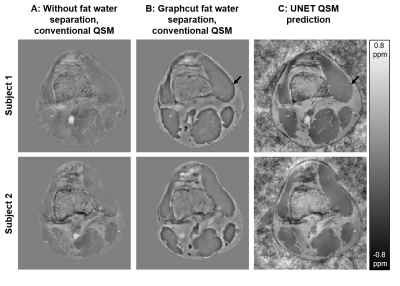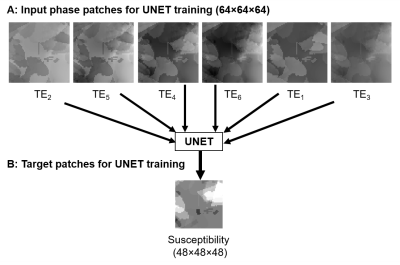Jannis Hanspach1, Aurel Jolla1, Michael Uder1, Bernhard Hensel2, Steffen Bollmann3, and Frederik Bernd Laun1
1Institute of Radiology, University Hospital Erlangen, Friedrich‐Alexander‐Universität Erlangen‐Nürnberg (FAU), Erlangen, Germany, 2Friedrich-Alexander-Universität Erlangen-Nürnberg (FAU), Erlangen, Center for Medical Physics and Engineering, Erlangen, Germany, 3University of Queensland, Brisbane, Australia, School of Information Technology and Electrical Engineering, Brisbane, Australia
1Institute of Radiology, University Hospital Erlangen, Friedrich‐Alexander‐Universität Erlangen‐Nürnberg (FAU), Erlangen, Germany, 2Friedrich-Alexander-Universität Erlangen-Nürnberg (FAU), Erlangen, Center for Medical Physics and Engineering, Erlangen, Germany, 3University of Queensland, Brisbane, Australia, School of Information Technology and Electrical Engineering, Brisbane, Australia
In this work, we applied a UNET to reconstruct
susceptibility maps in the presence of fat from unwrapped phase maps by using synthetically generated multi-echo phase data. The approach is well-suited to rapidly reconstruct high
quality in vivo susceptibility maps outside the brain.

Figure 5:
Axial knee/ upper thigh susceptibility maps of a conventional QSM pipeline
without fat water separation (A), of a fat water separation pipeline and
subsequent conventional QSM pipeline (B) and the UNET prediction (C) of two
subjects. Susceptibility maps of both subjects are proximal to the knee joint,
while the susceptibility maps of Subject 2 are further distal at the level of
the patella. Black arrows highlight artifacts at the border between subcutaneous
fat and muscle, which are improved in the UNET prediction.

Figure 2: Illustration of the training process. Randomly cropped input and target data of the above data set,
which served as training data for a UNET. The order of the input phase
patches was selected randomly for each data set to avoid overfitting and to
ensure that the network is not focusing on specific echo times recognized solely
by the input order and not due to the image contrast.
